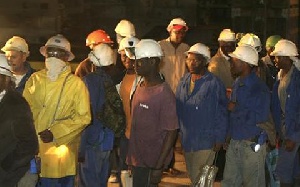The Chamber of Mines says the mining industry continues to be faced with increasing input costs as well as fees and charges from Metropolitan, Municipal and District Assemblies (MMDAs).
According to the chamber, the cash cost of gold production went up 25% from US$768 per ounce in the first half of 2012 to US$962 per ounce in the same period in 2013.
The Director of Analysis, Research and Finance at the chamber, Sulemanu Koney, speaking at the 4th Mining for Development Forum under the theme “Rising Costs, Falling Prices: Complications for Industry and the State”, said the drivers of the sharp increase include the cost of diesel, labour, and consumables.
“I wish to explain that cash cost does not reflect the total cost of gold production as the metric captures only operating, administrative and refinery charges -- excluding depreciation, depletion, amortisation as well as closure and overhead cost,” he said.
This situation, he said, has unfortunately led to the discontinuation of some exploration and brownfield projects, and rationalisation of inputs including labour.
The industry has already announced it will undertake massive job-cuts by the end of the fourth quarter of 2013 as part of its strategy to streamline cost structure and improve business-efficiency.
Newmont Ghana is terminating the employment of approximately 300 of its miners, whilst AngloGold Ashanti’s (AGA) Obuasi Mine is also expected lay-off about 430 of its miners.
The industry, which has been buoyant in the past few years, has witnessed a slump in gold production by about six percent in the first half of 2013.
Mr. Koney explained that the decline in the price of gold -- equivalent to about 25%, has necessitated a review of mining projects, with preference for those that offer optimal returns. In addition, companies are deepening productivity and efficiency-enhancing measures to ensure their survival.
“In the prevailing circumstances, mining companies have taken a big hit, with squeezed margins and key performance targets extremely difficult to achieve.”
Commenting on the impact on the economy, Mr. Koney explained that the situation of rising costs and falling prices of the metal has been acute, in spite of a favourable outturn from the oil and gas sector.
“Self-assessment of taxes paid by the mining companies to the Ghana Revenue Authority shows sharp decreases in mineral royalties and corporate tax payments to government,” he said, but did not reveal any data.
“This has been worsened by the rather large fiscal deficit the country recorded at the end of 2012,” he added.
The Chief Executive Officer of the chamber, Dr. Toni Aubynn, said: “The falling price of gold and the rising costs have negative implications for the economy. The government will not get the expected revenue from companies, and this will impede future expansion projects. This will be a challenge for everybody.”
Campaign Coordinator of the Integrated Social Development Centre (ISODEC), Dr. Steve Manteaw, called for the development of a fiscal regime that would be sensitive to the changes in the mining industry “so that fees, levies and taxes could be adjusted when there is a boom”.
He did not however completely share the pain of the industry. “The industry is complaining about falling gold prices, but that cannot be a problem. Even the US$1,300 per ounce the industry is enjoying is one of the best price levels in the last hundred years.
“The industry players must give Ghanaians a better reason for them to be concerned about this development,” he stated.
Business News of Friday, 1 November 2013
Source: B&FT

















